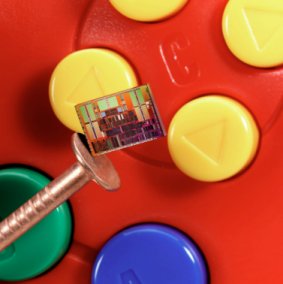Read about the history, the future and Nintendo's deals with the Computer Chip manufacturer
IBM
What’s IBM about? What is the company's History?
Unless you’ve been sleeping Rip Van Winkle style, the name “IBM” should instantly bring computers to your mind. Rightfully so, as IBM’s history of computers can be traced back to the Industrial Revolution, when they were incorporated in the state of New York on June 15, 1911 as the Computing-Tabulating- Recording Company. The company sold scales, measures and punch card tabulating machines. Invented by a German immigrant named Herman Hollerith, the punch card machines were timesaving devices for the Census Bureau and IBM’s first primitive “computer.”
During WWII, IBM served the US Government by constructing engine parts, bombsights and even rifles. It was during this time that they began their foundation in computers, with the invention of Mark I, AKA the Automatic Sequence Controlled Calculator. The Mark I was colossal machine, which could solve math problems in seconds—much slower than modern calculators but in 1944, it was quite the marvel.
Since the Mark I, IBM has remained at the forefront of technology. In 1964, IBM introduced the concept of interchangeable software and peripheral upgrades to computers. In the 70s, they developed computers that would evolve into Automatic Teller Machines. The company is perhaps most notorious for igniting the PC industry in the 80s, introducing the IBM to homes and schools across America.
However, despite their tradition for success, 1993 saw the company in dire financial peril and ready to split up IBM. Enter Louis V. Gerstner Jr., a man who stepped in as IBM’s new CEO and lifted the company from its ashes. Stepping in from the outside, Gerstner had extensive leadership experience; he spent four years as chairman & CEO of Nabisco and 11 years at American Express as a top executive.
Gerstner quickly stabilized IBM and negotiated acquisitions such as Lotus Development Corp., and Tivoli Systems Inc. Services the following year. In 1995, Gerstner articulated IBM's new vision -- that network computing would drive the next phase of industry growth and would be the company's overarching strategy. Quickly leaving its troubles behind, by 1996, IBM’s market value had jumped $50 billion. Most astounding of all, IBM shocked the world when their computer, Deep Blue, defeated World Chess Champion Garry Kasparov—the first time a computer defeated a human opponent.
What is IBM’s Relationship with Nintendo?
Nintendo has made a $1 billion dollar deal with IBM, one of the leading computer developers in the world, to help with the GameCube system.
"Nobody else in the world can do what IBM does," said Howard Lincoln in announcing the partnership. "And quite frankly, anything less is simply not state of the art technology."
What Will IBM Be Doing for the Dolphin System?
IBM has designed the Dolphin system’s Central Processor chip, which is officially named is “Gekko.” IBM will produce Gekko chips at a high volume from their manufacturing plant in Burlington, Vermont and ship them to Nintendo.
What’s a Gekko?
The “Gekko chip” takes its name from small lizards called geckos –yes, the spelling is a little bit different. However, in the game The Legend of Zelda: Majora’s Mask there is an annoying reptilian creature that is called a “Gekko,” spelled the same way as the chip.
Dolphin? Gekko? What’s with all the Animal Names?
Ah, what’s in a name? Funny story: at E3 ’99 when all these “animal names” were being announced by Nintendo. Nintendojo successfully tricked FGN Online into thinking that the Gameboy Advance would have a squirrel mascot & be nicknamed “NutBiter.” For more details on this fun antic, check out Fatbabies 9/26 report "FGN Online: Part Deux."
But we digress…. (*snicker*)
What is this Gekko Processor?
Built with advanced 0.18 micron copper technology, the Gekko Chip is a processor that expands on IBM’s PowerPC architecture. Gekko includes 256KB of Level 2 cache on-chip memory, allowing high efficiency data management between the Gekko processor and Flipper, the GameCube system’s primary graphics chip—provided by Art-X.
Is the Gekko Final Design Complete?
Yes. This was confirmed at E3 2000, a year after the chip was announced. Preparation for full-scale production has been well underway for some time now.
How Large is 0.18 microns?
Pretty small. For comparison, 100 microns is the diameter of one human hair, which is as small as the naked eye can see. The 0.18 micron copper technology used in Gekko is quite “itsy-bitsy,” yet efficient. In fact, the chip is so efficient that it won’t need a fan. Neither will “Flipper” for that matter.
How Large is the Gekko chip itself?
The picture below compares the Gekko chip’s size alongside a nail and N64 controller buttons.

How Powerful is the Gekko?
The Gekko chip will be a unique 485 MHz central processor.
Gekko will certainly allow for better games, a fact that is appreciated by Nintendo’s greatest game maker of all, Shigeru Miyamoto.
"In my mind, I'd always envisioned what a game like Zelda could look like, and with the N64, I was able to create it," comments Shiggy on Gekko. "Now, with the Gekko processor, I can see an opportunity to take game designs to a new level."
In regard to the Gekko, Howard Lincoln had this to say "… it will be the fastest and most powerful CPU in any home videogame system… period."
Will IBM Do Anything Else with Nintendo?
At present, Nintendo & IBM’s relationship is strictly GameCube, though both companies are exploring potential applications for IBM technology in Nintendo products. IBM is a strong new ally for Nintendo, and it has publicly expressed interested in working with Nintendo more. So future collaborations between the two companies would not be surprising.